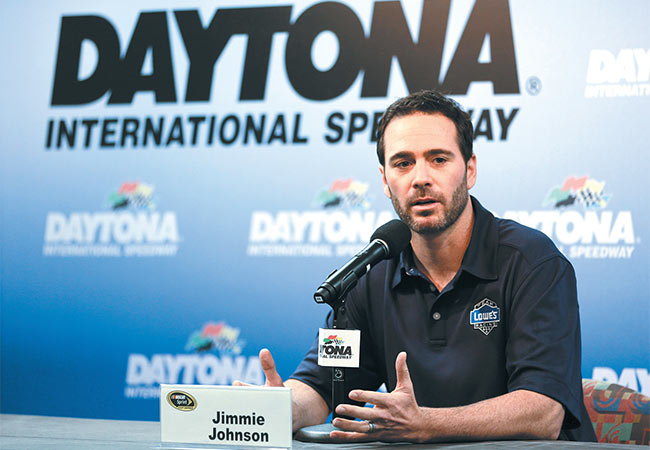NASCAR Qualifying Gets Tougher
In a sport with a history written by those best able to work outside the rules, NASCAR should be congratulated for stealing a good idea.
Vice president of competition Robin Pemberton announced last week that NASCAR is dropping its single-car qualifying system in favor of group qualifying, similar to those used in Formula One and IndyCar. The seemingly minor revision is long overdue and brings much-needed change to the often boring lead-in to the eventual race.
Under the old system, drivers would race against the clock for two laps, with the quickest time taking the pole and the others in descending order of quickness.

NASCAR’S qualifying change could mean more pole positions for Jimmie Johnson as he contends for a record-tying seven Sprint Cup Championships | AP photo
Now, teams are just gonna race.
On tracks that are 1.25 miles or longer, qualifying cars will race against each other for up to 25 minutes. Those who finish in the top 24 will then race in a 10-minute session, with the top half of that group going on to a final five-minute round. The first session will determine starting spots 25-43, the second 13-24, and the final race determining the top 12. Rules will be slightly different for tracks less than 1.25 miles in length.
What once was tired and rather boring becomes a race that may actually determine the race.
For years, race teams have been challenged to find enough time to set up their cars for both qualifying and racing. Success for an empty track sprint is very different from the crowded, dirty-air conditions of a 500-mile race. It’s hard to do both equally well. Turning qualifying into a race helps to eliminate one of the steps, and it also provides a clearer look at how the race may actually play out.
Single car qualifying was necessary in the sport’s infancy because differences in design, setup and funding segregated the field. Separation along class lines was needed to prevent the also-rans from mucking things up. Modern NASCAR rules have created near-identical cars, which puts greater emphasis on setup and driver ability. The extra time to prepare should be beneficial.
No change comes without concern, and race officials will be watching closely to make sure everyone plays nice.
Blocking is a big concern. Last season, Michael Wal-trip Racing, Penske Racing and Front Row Motorsports were punished for purposely using their cars to improperly help or hinder other racers. With 43 cars running simultaneous qualifying laps, there is a real threat that drivers will try to alter starting positions to favor teammates or hinder major competitors. If it happens, it’ll be a short-term phe-nomenom. Anyone found guilty will get hammered – hard.
So far, driver reaction has been positive.
Jeff Gordon and Elliott Sadler were quick to tweet their support, while Jimmie Johnson’s crew chief Chad Knaus publicly showed his pleasure in interviews. And why not? He’s got the best driver and is employed by its best team, Hendricks Motorsports.
Fan reaction to the change remains to be seen. A Jan. 24 ESPN SportsNation poll found the 30,000-plus voters equally split in their support and criticism of the change. It’s hard to imagine the numbers not swinging in NASCAR’S favor.
Fans pay to see racing, and group qualifying turns a solo exercise into an actual competition.
How can more racing not be better?





